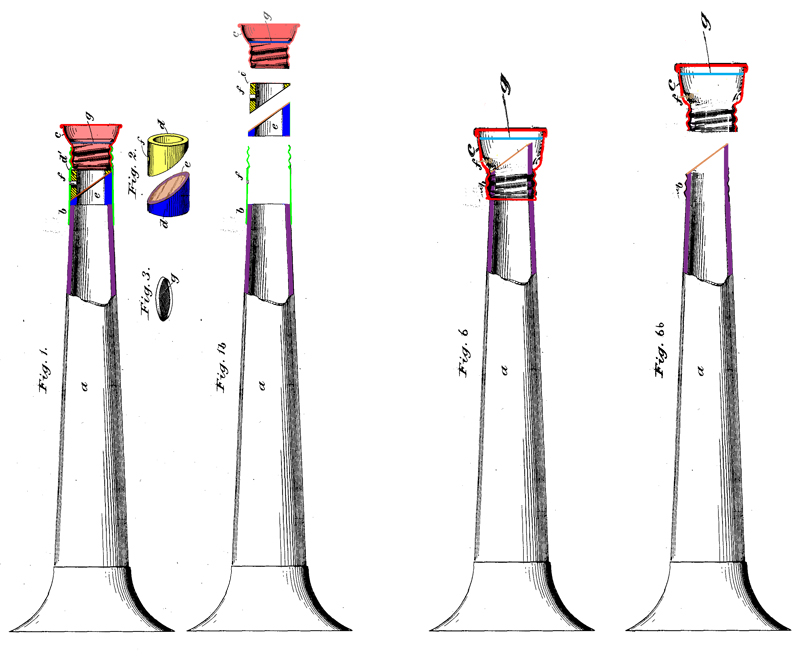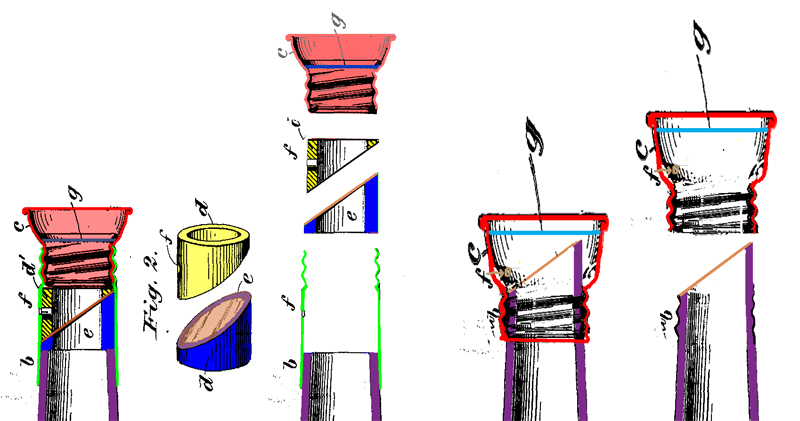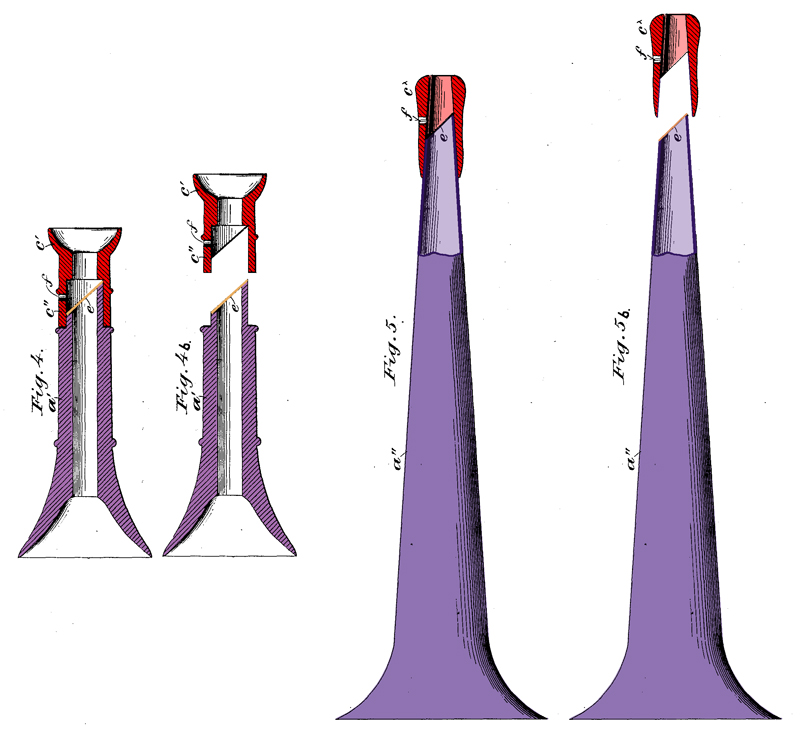
Kazoo Structure
|
Kazoologist Home What Is a Kazoo? History of the Kazoo Join AAK Kazoo Design, Construction, &Maintenance Pictures Links |
Year #
1900__663654_CRAKOW--Songophone------------------------Louis
N. Crakow---------Songophone
Patent
The diagram from the patent shows three versions of this instrument, figures 1, 4 & 5  Diagram of Figures 1, 2, & 3 from Patent Figures 6 & 6b. Diagram of an actual Songophone from some of the instruments I have. Colored to show the different parts.
Diagram of Figures 1, 2, & 3 from Patent
Figures
6 & 6b.
Diagram of an actual Songophone from
some
of the instruments
I have. Fig. 1-- includes Figures 2 and 3
a--the body is a
trumpet like resonator,
which may be of pasteboard as shown in figure 1. the smaller end goes
into d--removable holder fits into the thimble (b) it holds the e--the tympanum (diaphragm or membrane stretched tightly--like a drum) across the oblique surface of d. d' -- keeper or guard
f--an outlet in thimble b and at the guard d' (if there is a guard) for the breath from the mouthpiece after it impinges on the tympanum e and is deflected at substantially right angles to the axis of the mouthpiece. g-(navy blue)-a softening diaphragm g that fits in the mouth piece . (Seen detached in Fig. 3). This diaphragm is preferably removable and consists of a fine wire-mesh provided with a marginal band or rim, which will be by preference rubber, but may be of other material. This diaphragm softens the tone of the instrument somewhat in the manner of the soft pedal of a piano or the damper of an organ. The Removable holder (d)-- with the tympanum (diaphragm or membrane stretched tightly--like a drum) across the oblique surface is placed into the thimble ( b). The keeper or guard (d') is placed into the thimble on top of the removable holder (d) aligned with the hole f. The mouth piece (c) with the softening diaphragm (g) is screwed into the thimble, thus holding the holder, guard and tympanum in place. A diagram of Songophones that I have is shown to the right side of the two images above. (Figures 6 and 6b) The instrument is made of brass coated steel. There is no removable holder, guard, or thimble. The tympanum is glued directly onto the oblique surface of the metal body or resonator. Although I can not say for sure if that was the way it was originally made, or if it was done that way later because some kind of guard or keeper was lost. I can not see that there would be room or a way for a guard to fit within the mouth piece. The mouthpiece screws onto the threads of the body. The softening diaphragm (g) is a perforated metal disk wedged into a groove in the mouth piece. I have yet to determine the material the membrane is made of, nor do I know if it is original or replaced at a later date.
Simpler Versions--Figures 4 & 5
These two
simpler versions have just a mouth piece (in red),
a body referred to as a resonator
(purple),
and a tympanum or membrane (e --
in orange) .
Neither has threads, the mouth pieces slide down over the
resonator.
Figure 4 is made of wood. It has a mouth piece (c' and c"), a body referred to as a resonator (a'), and a tympanum or membrane (e) . The membrane is attached to the oblique end of the resonator by any suitable means, such as cement. The lower end of the mouth piece slides over the upper end of the resonator. The neck (c") of the mouth piece forms the tympanum-chamber with an outlet hole (f). Figure 5 has a conical sheet metal body or resonator (a") the lesser end of which is cut off at an oblique angle to which the tympanum or membrane (e) is attached. A wooden mouth piece (c^), slips over this end and forms the tympanum-chamber with an outlet hole (f). In all versions, the face of the tympanum or membrane (e) is oblique to the axis of the mouth piece and the hole (f) is opposite to the oblique face. The tympanum is strained tight and is elastic or resilient, so as to vibrate under the influence of sound waves. When the softening diaphragm g is made removable, it may be used or not, so that the instrument will produce stronger or softer sounds, as desired. The obliquity to the direction of the breath pulsations of the vibrating surface of the tympanum not only increases the area of said surface over that produced by placing the tympanum with its surface at right angles to the axis of the mouthpiece, but it avoids the deflection of the air pulsations back in the direction of their approach, and thereby produces clearer and less-confused sounds or notes. |


